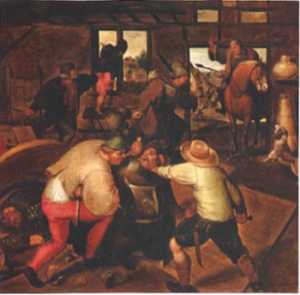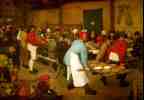 Peasants
Murdering a Soldier, Marten van Clève,
1566.
Peasants
Murdering a Soldier, Marten van Clève,
1566.Inside, there are boards (tables) to sit at and forms (benches) to sit on. There are also three-legged stools and the occasional cut-down barrel being used for a gaming table. By the hearth, there is a high-backed settle with broadsides and such tacked to the back. There is a chest near the door that leads to the kitchen, and above it are shelves full of pewter dishes, earthenware mugs, and pitchers.
Since a typical home had only one room that served for kitchen, dining, living, and sometimes sleeping space, it was considered a great luxury to have a table (dining table or work table) that stayed up all the time. The average person used makeshift tables, made of wide planks laid on top of anything sturdy -- barrels, or a pair of saw-horse like 'trestles'. This allowed the table to be knocked down and put out of the way against a wall when it wasn't needed. This was useful, considering the limited space. The furniture in taverns is often particularly crude.
A 'table' was what modern people think of -- the permanent structure. The period English term for these temporary structures was 'board'. Many modern phrases come from the term, such as 'room and board' or 'groaning board', or even the SCA's own 'off-board' and 'on-board'.
The household sat at the table on forms (benches). There was probably one chair, and it belonged to the master of the house (the "chair-man" of the "board"). Even in a poor home, people did not usually eat off a bare wooden table -- they used table cloths and had for hundreds of years. This is typically plural, because the standard cloth being 26" wide, two were laid side-by-side, with a third one laid down the middle over the two butted edges.
We have trestle tables and boards on sawhorses in Le Poulet Gauche. We will do our best to keep them stable, but keep in mind that they are just planks and are not nailed or glued to their legs. It is our opinion that the rule of dining etiquette that says "no elbows on the table" may be a reflection of the fact that if you lean too heavily on such a table, you will flip it over and greatly discommode your dining companions.
Do not attempt to sit in Monsieur Jehan du Lac's chair.
It's rather dark in le Poulet Gauche. Most of the light comes from the fire in the hearth. There are some tallow candles and grease lamps here. Beeswax candles are extremely expensive and mostly are to be seen in churches. Because modern people would find tallow smelly, smoky, and disagreeable to their allergies, we are using better quality candles than Le Poulet Gauche could really afford. The oil lamps will also not be too much in evidence, as they are open flames, with wicks sitting either in flat, padlock-shaped clay or metal bowls or in a lipped goblet-like earthenware bowl, and represent a little too much fire risk for modern comfort (especially as we expect someone will discover the hard way about elbows on the table).
Also, out of deference to the many hay-fevers our patrons report, we will not be strewing the floor with a nice, healthy covering of rushes or straw, but it ought to be there to soak up the mud from your traveling boots.
 Peasants
Murdering a Soldier, Marten van Clève,
1566.
Peasants
Murdering a Soldier, Marten van Clève,
1566.A visit to the Poulet Gauche is not usually so violent, but this scene
gives a fair idea of the interior of a country inn, which is a much cruder
place than one in a city as prosperous as Calais. As you can see, the boards
have been knocked over. One malefactor is climbing out the window on a
form. A soldier has ridden through the door on his horse, not a common
occurence here in town. The painting illustrates a common antagonism --
peasants suffered a great deal at the hands of marauding bands of soldiers
from every side, and stragglers had much to fear if they were caught in
a weak moment.
 For
a more cheerful scene, this wedding is probably taking place in a rural
inn. Click on the thumbnail to see the full image in the WebMuseum.
Note the settle to the far left of the picture, which has broadsides tacked
to it just like ours.
For
a more cheerful scene, this wedding is probably taking place in a rural
inn. Click on the thumbnail to see the full image in the WebMuseum.
Note the settle to the far left of the picture, which has broadsides tacked
to it just like ours.